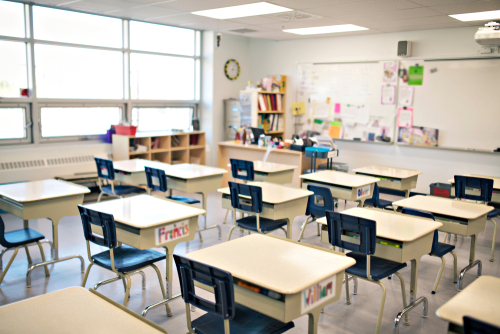The Center for Green Schools at the U.S. Green Building Council (USGBC) released a new report, “School Facilities Funding in the Pandemic,” which found U.S. school districts are widely committing funding from last year’s American Rescue Plan (ARP) to upgrade or improve their air filtration and heating/cooling systems—more so than for other facility improvements.

The report analyzes facilities infrastructure funding categories and found that after spending for staffing, air filtration/HVAC was the second-highest category for district planned spending at $5.5 billion. The other categories the report analyzed included $2.6 billion planned for repairing/improving school facilities; $271 million for upgrading windows, roofs, and doors; and nearly $11 million for UV lighting for disease mitigation. In the air filtration/HVAC category and the repairs category, the average planned spend is approximately $260,000 per school. Around 500 school districts plan to spend over $1 million per school on one or both of these categories.
“Federal funding has given school districts a financial lifeline to make improvements at schools and help reduce the risk of COVID infection. These upgrades can go beyond the pandemic and yield positive results that last far into the future,” said Anisa Heming, director for the USGBC Center of Green Schools. “By investing in school facility upgrades, these schools are creating healthier working and learning environments for staff and students, and we will continue to encourage districts to allocate remaining funds to green building strategies that improve health and operational performance.”
The report analyzes the spending plans of 5,004 school districts from all 50 states and the District of Columbia in conjunction with interviews with three school districts and identifies how districts are planning to spend billions of Elementary and Secondary School Emergency Relief (ESSER III) funds allocated by the American Rescue Plan.
Other key findings from the report include:
- Small and midsize districts (those with 20 or fewer schools) consistently reported more spending on facilities categories than their larger counterparts.
- Of the 2,379 school districts that planned to spend any ESSER III funding on facilities, large districts planned to spend the lowest percentage (on average, 22%) and small districts planned to spend the highest percentage of their total allocation (on average, 30%).
- In addition to filtration and HVAC improvements, in most cases, districts that planned to spend in this category also indicated plans to spend in at least one other facilities category, displaying a layered approach to addressing COVID at the building infrastructure level.
- District interviewees highlighted the importance of having substantial federal dollars to invest in costly HVAC infrastructure projects, which would otherwise be delayed or addressed in phases. However, they also noted that they face real constraints on their projects caused by the pandemic, associated supply chain issues, and the rising rate of inflation.
- District interviewees noted that where HVAC upgrades were made in their schools, they were able to keep energy usage and costs to a minimum compared to schools with outdated systems. Similarly, districts reported positive results from spending in other facilities categories to reduce the spread of COVID in the school buildings.
The report was compiled using a dataset from Burbio data service, which analyzed ARP-ESSER spending plans from school districts that spanned all 50 states and the District of Columbia, representing roughly 74% of public K-12 enrollment nationwide.
The Center for Green Schools’ work to develop and release this report was made possible through generous support from Carrier Global Corp. The full report can be found here.
